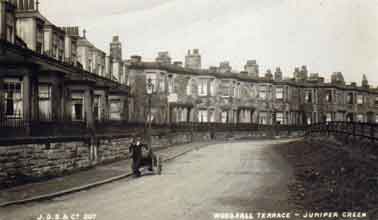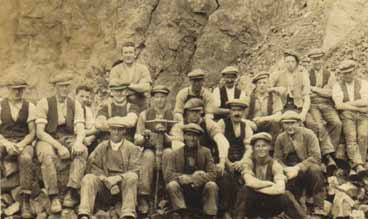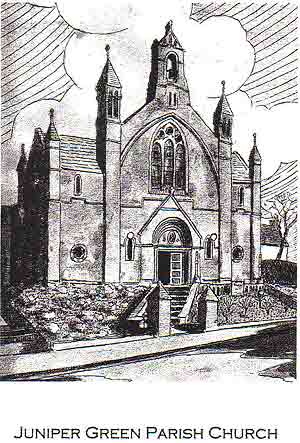Memories of Juniper Green
I remember... Mrs Marie Salton, born 18th October 1920 remembers the Juniper Green of her youth
This is a reminiscence Interview for JG300 by Lynda Anderson and Liz Beevers.
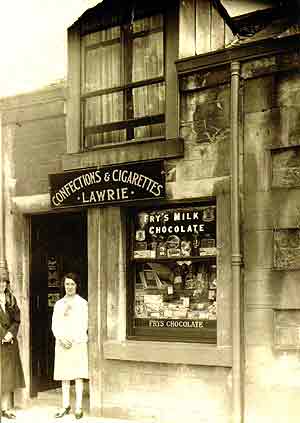
Lawrie's sweetie shop at Hillside in Juniper Green in the 1930s. This is now the site of the Al Borgo restaurant and the Pentland Fry.
I was born Marie Culbert and the address on my birth certificate was East Mill Currie. My parents were in digs there. Then they moved to Juniper Green and rented a house at St Ann's Park (Belmont road) It had no bath and we had to go to the Village Hall for a bath so, when my sister was born, we moved to Hillside (now rebuilt as Al Borgo & Pentland Fry) There was a block of houses then, a sweetie shop, our house and the butcher's.
In 1934 we moved to 24 Woodhall Terrace, built for us by Mr Mackenzie which was a six-apartment house.
You didn't enjoy school you just went!
Marie went to Juniper Green primary at nearly six, 1926-1931, then to Boroughmuir I went to the infant classes under Miss Mulholland (it was her little kingdom) then junior 1 and 2, senior class1 and 2 and then the the qualie class. There were two famous teachers Helen & Janet Fraser known as Nell & Net: the bedrock of the school! They were local and everyone knew them. Miss Fraser (Nell) taught the qualifying class. I liked her - she kept good discipline.
Upstairs there was the art room and downstairs the cookery room and woodwork room. (That was for the advanced division: those who did not pass their qualie and stayed until the leaving date.) When I started, the school was in Midlothian - there were only two senior secondaries in the county: at West Calder and Dalkeith. When I sat the qualie Juniper Green was in Edinburgh and I went to Boroughmuir. Some others went to Tynecastle.
Mr J J Malloch left the school the year I did and as the dux I made a presentation to his wife. He taught the older pupils: he didn't have much to do with us. He wielded the belt known as a lochgelly. We had weekly or monthly exams & we moved (our position) up the class, to the back if you did well. I was the dux in 1931.
Do you know what primary teaching was like? We had analysis & parsing counting & a visiting teacher for music and sewing while the boys had one for woodwork. I made a lapbag in sewing. We used to do "run and fell" (stitch). But I liked knitting... my mother trained me, lots of tears!
On a schoolday we gathered in the playground, and there was the well... this was on the wall, there was a supply of water, stone basin and a stone mug thing, which you could drink out of. If you were very posh you put your finger between your lip and the cup while you're doing it.
Then the bell rang and a teacher thumped the piano and we all marched in and went to our own classrooms, we didn't have assemblies or prayers as such.
We went home for our dinner but we might have an apple or a biscuit for our playpiece. We played with skipping ropes but I don't think we had peevers because the playground wasn't smooth enough. You didn't enjoy school you just went!
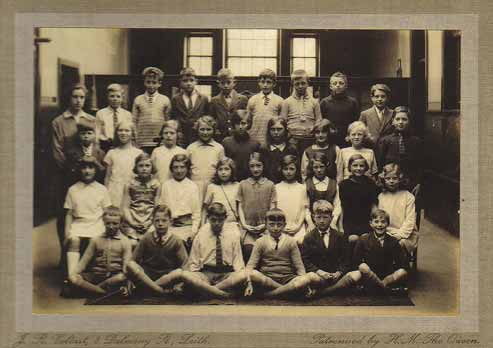
Miss MacGregor's class in 1930. Marie Culbert is in the third row from the front and third in from the left.
Looking at the picture, You see four or five boys here who didn't come back from the war. It's senior 2 (Primary 6 ) 1929/1930, It's Miss Macgregor in the picture and I'm third row from the front and third in from the left. I'm just starting to grow my hair.
After school
After school we went home and changed and then out to play. We went down the burn and were guddling for minnows. Our other great howff was from the back of St Margaret's church where you could get up on the railway embankment and my sister and I would go along there and have our wee houses. We had a highly skilled way of nicking flowers out of the gardens of the big houses on Lanark Road. In winter we had the sledging field up beside the quarry brae. The dooking hole was below the weir just above the station but my parents wouldn't allow me to swim there.
All the houses backing on the river near us were supposed to have a high wall so as not to overlook Woodhall House and grounds.
We'd go and watch the horses being shod at the smiddy at the top of Belmont Avenue (now Juniper Avenue).
Employment
Kinleith was the biggest employer but the quarrymen went down past our house, down the station brae, across the river and then up to the quarry. They stayed above Mairwood (NOT "muir"wood to us!) in the corporation houses there: they were the quarry houses.
I do remember all the lorries with the esparto grass going up to Kinleith through the village. I remember the wonderful smell - they would use lye on the grass or something to break it down.
Characters
Jimmy Leishman chewed garlic, wore a beret and played the fiddle. He had a notice on the park lane "Please practice canine culture in this lane" when the war came he said "I'm here if you want to use me" but he didn't take part in any of the voluntary things. His father made money as a builder so I imagine they lived on that money.
There was a gaun-aboot body (Anne Kane). She had a howff down Muirwood road but the children didn't go near her. She must have lived on charity and when she died a collection was taken to give her a proper burial. The village was a community like that.
Reverend John Henderson was Minister at St Margaret's in the war but I think he was "out-at-elbows "with the village. Then Mr Denis Duncan came but he left to go to London.
Dr Mackay lived in the Muir House ( Editor: now Baberton Court) . He came to your house... none of this surgery stuff. Dr Moir was a character. I don't think he had much time for women's troubles but if you were dying he was great! He had a healthy attitude to illness. He had a mother-in-law Lady Auchterlonie who went around on a tricycle in her widow's weeds.
Mr Porteous, of the Johnnie-a-thing shop, married a Jeannie Tweedie and she once told me she had over 80 cousins! It was one of the big families in the village. So were the Bryces. There was Barrel Bryce and the Bryces who had the pub (the Kinleith) and the Misses Bryce who stayed at St Ann's (one of the big houses) One of the Bryces was at the farm at Whitelaw and Mary from that family was in charge of the McVitie's in Colinton. She had to walk back to Whitelaw (at the far end of the golf course) so her mother had a wee oil lamp which she put in the window to help the family find their way across the golf course at night.
My Family
My father was a peripatetic teacher of handwork and worked in Midlothian - East Calder, West Calder & Currie. He never landed a permanent posting. My mother had been a teacher: she was the force behind the throne! There were three of us all girls. I was the eldest. My sisters both became teachers; it was the usual occupation. My sister later lived in St Regulus on Lanark Road- Mrs Agnes Bruce who taught in Juniper Green school until her retiral c.1983.
All my aunts & uncles (on the Logan side) were in the area, married in the area.
We had an aunt staying with us -Auntie Jeannie (Logan) She was the eldest daughter and had stayed with her parents until they died then came to live with us. So there were two to do the housework (my mother and my aunt).
My Father was "parish" Church of Scotland so he went to Currie. He sang in the choir there and was the presbytery elder. But my aunt was Free Kirk and we went with her to St Andrew's to the Sunday School. Miss Watson took the little ones and Mr Brydon took the others. He was a wee man with red hair (what was left!) I joined Currie when I was old enough.
The Church was the social centre of the village with Sunday School picnics and parties and even a Literary Society.
Both my parents were members of the Golf Club but my father had a "cast-out" with them. He said it was an artisan golf course but the folk coming into Juniper Green had big ideas , wanted to upgrade the whole thing at great expense. In those days the women weren't allowed in the main door -they had to go up the outside stair otherwise they'd have seen the men drinking in the bar. My mother played but I can't even hit a tennis ball.
One of my grandfathers was Thomas Logan. The Logans had Byrnie mill in Balerno from 1798 (later absorbed into Galloways.) He was the youngest of the family so he became the Balerno baker. He retired to Juniper Green and stayed at Arthurville (5 Lanark Road West) over the boundary with Currie. They were next door to the Turners. (Editor: Mr Turner was a builder and built the two Churches in Juniper Green and the one in Balerno.) He had a builder's yard on the corner of the Muirwood Road where we played at see-saws on the wood.
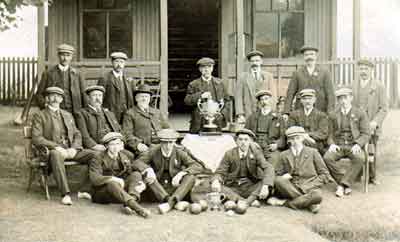
Mr Thomas Logan, one of the early members of the Bowling Club, is seen here holding a trophy. He retired to Arthurville on Lanark Road West.
Gas and electricity
Hillside had gas and the water was heated from the living room fire. You pulled the flue out and the heat went up the back to the boiler. It was gas lighting which you lit with a match but in the lobby there was a "bypass" with a posh pink shade. You pulled the little chain down and it came on straight away. When we went to 24 Woodhall Terrace in 1934 there was electricity in it although we used a gas cooker. It was a cold house during the war when coal was severely rationed.
Health matters
You got checked for nits at school and every home had its fine tooth comb. I don't think there were any other health checks.
My mother went to a nursing home for her babies. We never knew about babies: they just appeared. There was a Mrs More stayed in the village. She knitted socks for gentlemen who wanted hand-knitted ones and she laid people out when they died. As children we were protected against all that. We were one of the fortunate families in that we had a bathroom. Lots of people had a wash basin and a "lavvy" out the back.
Shopping
Shopping was different when I was a child: my mother sent a line to the grocer and the butcher of what she wanted and it was delivered. I remember buying threepence worth of teabread from Mr Graham the baker and that was seven pieces including Paris buns - "plaster of Paris" we said! We didn't patronise the store: my Father didn't approve. Bread was plain or pan the latter being slightly dearer. We bought very little from the baker as there was always home baking on the table. At the appropriate times there was prepared a year's supply of home-made marmalade and jam, using the big copper jam pan.

